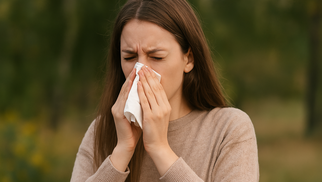When Allergies Hit the Nose and Eyes


Allergic diseases are among the most common chronic conditions worldwide, and two of their most frequent manifestations are allergic conjunctivitis and allergic rhinitis. These conditions, although involving different organs — the eyes and the nasal passages — are closely interlinked, often sharing triggers, mechanisms, and even treatment strategies. Understanding how they develop, what symptoms they cause, and how modern therapies such as antihistamines like Allegra (fexofenadine) help patients is essential for both medical professionals and those who suffer from these conditions.
Understanding Allergic Conjunctivitis
Allergic conjunctivitis is an inflammation of the thin membrane covering the white part of the eye and the inside of the eyelids, known as the conjunctiva. This inflammation occurs as a result of an overreaction of the immune system to allergens such as pollen, dust mites, mold spores, or pet dander. When allergens come into contact with the eye surface, mast cells in the conjunctiva release histamine and other inflammatory mediators, causing the hallmark symptoms.
Patients often present with red, itchy, watery eyes that may also feel gritty or burning. Swelling of the eyelids is common, particularly after prolonged exposure to allergens. In many cases, both eyes are affected simultaneously, which distinguishes allergic conjunctivitis from some infectious forms that can begin in only one eye. Blurred vision and photophobia (light sensitivity) may occur in more severe cases, although these symptoms are less frequent.
Treatment is aimed at reducing exposure to allergens and controlling the allergic response. Non-pharmacological approaches include avoiding outdoor activities during high pollen counts, using sunglasses to reduce exposure, and applying cold compresses to relieve irritation. Pharmacological therapy typically begins with antihistamine eye drops that block the effect of histamine, and may be combined with oral antihistamines for systemic relief. In persistent or severe cases, mast cell stabilizers or dual-action drops are prescribed, while corticosteroid eye drops are reserved for short-term use under medical supervision due to potential side effects.
Allergic Rhinitis and Its Overlap with Eye Symptoms
Allergic rhinitis, often referred to as hay fever, is characterized by nasal congestion, sneezing, itching, and a runny nose triggered by exposure to allergens. Much like in the eyes, allergens stimulate mast cells in the nasal mucosa, releasing histamine and causing swelling of nasal tissues. The inflammation not only affects the nose but can also extend to nearby structures, which explains why many patients with allergic rhinitis experience ocular symptoms as well.
The overlap is so strong that doctors frequently refer to the “allergic rhinoconjunctivitis” complex, highlighting the inseparable relationship between nasal and ocular allergies. Indeed, allergic rhinitis is considered one of the main causes of allergic conjunctivitis. Patients often report simultaneous itching in the nose and eyes, excessive tearing, and difficulty breathing through the nose during high allergen exposure seasons such as spring or early summer.
This close connection also means that effective management often requires a combined approach, treating both nasal and eye symptoms together rather than focusing solely on one site.
Can Allergic Rhinitis Lead to Eye Problems?
Because allergic rhinitis is primarily a nasal disorder, patients may initially assume that their eyes should remain unaffected. However, the proximity of the nasal passages and the eyes, connected by the nasolacrimal duct and surrounded by shared mucosal tissue, makes cross-involvement highly likely. The inflammation triggered in the nasal mucosa often spreads to the conjunctiva, leading to watery, red, and itchy eyes.
In fact, eye involvement is one of the most common “extra-nasal” manifestations of allergic rhinitis. Patients who do not address their nasal symptoms adequately often find that ocular discomfort persists or worsens. In long-standing cases, rubbing the eyes continuously may lead to secondary complications such as keratoconjunctivitis or thickening of the eyelid skin. Thus, controlling allergic rhinitis is not only about relieving nasal congestion but also about preventing eye problems that can significantly impair quality of life.
Recognizing Red Flags in Allergic Rhinitis
Most cases of allergic rhinitis are benign, though uncomfortable. However, there are red flags that should prompt medical evaluation. A particularly concerning sign is the sudden worsening of symptoms outside of allergy seasons or in response to triggers not previously associated with allergy. Severe obstruction of nasal breathing, associated facial pain, or recurrent nosebleeds may indicate alternative diagnoses such as sinus infection, nasal polyps, or, rarely, more serious conditions requiring specialized care.
Another important red flag is when rhinitis symptoms are accompanied by systemic signs such as weight loss, fever, or chronic fatigue, which do not typically belong to allergic disease. Such cases warrant further investigation to exclude chronic infections or autoimmune processes. Finally, allergic rhinitis that is uncontrolled despite optimal therapy and allergen avoidance should be reassessed by a physician to ensure that no other overlapping conditions, like non-allergic rhinitis or structural nasal problems, are complicating the picture.
The Classic Signs of Allergic Rhinitis
For most patients, allergic rhinitis can be recognized by a classic symptom triad. The first sign is sneezing, often in rapid succession, particularly upon waking or after exposure to allergens. The second hallmark is nasal congestion, which may cause mouth breathing, especially at night, leading to disturbed sleep. The third classic sign is nasal and ocular itching, an unmistakable sensation that prompts rubbing of the nose (sometimes leading to the characteristic “allergic salute”) and eyes.
Other features include rhinorrhea (clear watery discharge), postnasal drip, and decreased sense of smell. While none of these symptoms alone is diagnostic, their combination, especially with a personal or family history of allergies, strongly points toward allergic rhinitis.
Treatment Approaches and the Role of Allegra
Management of allergic conjunctivitis and rhinitis requires both allergen avoidance and pharmacological therapy. Allergen avoidance strategies, though difficult to maintain fully, play a critical role: minimizing time outdoors during high pollen seasons, using HEPA filters indoors, washing bedding frequently, and keeping windows closed can reduce exposure.
Pharmacological therapy revolves around antihistamines, which block histamine H1-receptors and thereby reduce sneezing, itching, and watery discharge. Among the modern antihistamines, Allegra (fexofenadine) has become a first-line treatment option. Unlike older antihistamines, fexofenadine is non-sedating, meaning it does not cross the blood–brain barrier in significant amounts. This makes it preferable for daily use, as patients can continue their normal activities without the drowsiness associated with drugs like diphenhydramine.
Allegra effectively reduces nasal congestion, sneezing, and eye symptoms when taken once or twice daily depending on the prescribed dosage. Clinical studies have demonstrated its rapid onset of action, with many patients experiencing relief within an hour. For those suffering from both allergic conjunctivitis and rhinitis, Allegra provides systemic control that complements topical eye drops or nasal sprays. Because it is generally well tolerated, with side effects such as headache or mild gastrointestinal discomfort occurring infrequently, it has become a cornerstone therapy in the management of seasonal and perennial allergies.
Other supportive treatments may include intranasal corticosteroids, which are highly effective for nasal congestion, and saline irrigations to clear allergens from the nasal passages. In selected patients with severe, persistent symptoms, allergen immunotherapy (allergy shots or sublingual tablets) may be recommended to gradually reduce immune system sensitivity to allergens over time.
The Broader Impact of Allergic Conjunctivitis and Rhinitis
Beyond physical discomfort, these conditions exert a significant toll on daily life. Patients with allergic rhinitis often experience poor sleep, daytime fatigue, and reduced concentration, which can affect academic and occupational performance. Allergic conjunctivitis, with its constant itching and tearing, makes reading, driving, or computer work challenging. The combined burden leads to a marked reduction in quality of life, particularly during allergy seasons.
Moreover, untreated allergic inflammation may predispose individuals to secondary complications such as sinusitis, ear infections, or exacerbation of asthma. In fact, allergic rhinitis is strongly associated with asthma, and managing nasal inflammation can reduce asthma exacerbations. This highlights the importance of recognizing and treating these conditions early, not only for symptom relief but also for long-term health outcomes.
Conclusion
Allergic conjunctivitis and allergic rhinitis represent two manifestations of the same underlying problem: an overactive immune response to common environmental allergens. Their frequent coexistence underscores the importance of treating them together rather than as isolated conditions. While avoidance of allergens forms the foundation of management, pharmacological therapy — particularly with modern antihistamines like Allegra — provides reliable and safe relief for most patients. Recognizing typical signs such as sneezing, nasal congestion, and itching, as well as identifying red flags that may signal more serious issues, ensures timely intervention and better quality of life. As medical understanding of allergic diseases grows, integrated approaches that target both nasal and ocular symptoms will remain essential in helping patients breathe and see more comfortably, free from the burden of seasonal or perennial allergies.
Drug Description Sources:
U.S. National Library of Medicine, Drugs.com, WebMD, Mayo Clinic, RxList.
Reviewed and Referenced By:
Dr. Stanley J. Szefler, MD Professor of Pediatrics, Director of the Pediatric Asthma Research Program at the University of Colorado School of Medicine. Recognized authority on allergic diseases, airway inflammation, and treatment strategies for rhinitis and asthma.
Dr. Leonard Bielory, MD Board-certified allergist and immunologist, Professor at Hackensack Meridian School of Medicine. Published extensively on ocular allergy, allergic conjunctivitis, and the interplay between rhinitis and eye conditions.
Dr. James Sublett, MD Clinical Professor of Pediatrics at the University of Louisville School of Medicine. Former President of the American College of Allergy, Asthma & Immunology (ACAAI). His work emphasizes environmental triggers and treatment of allergic rhinitis.
Dr. William W. Storms, MD Allergist and clinical researcher based in Colorado Springs. Contributed to numerous clinical trials on antihistamines such as fexofenadine (Allegra) and intranasal corticosteroids for allergic rhinitis and conjunctivitis.
(Updated at Oct 4 / 2025)